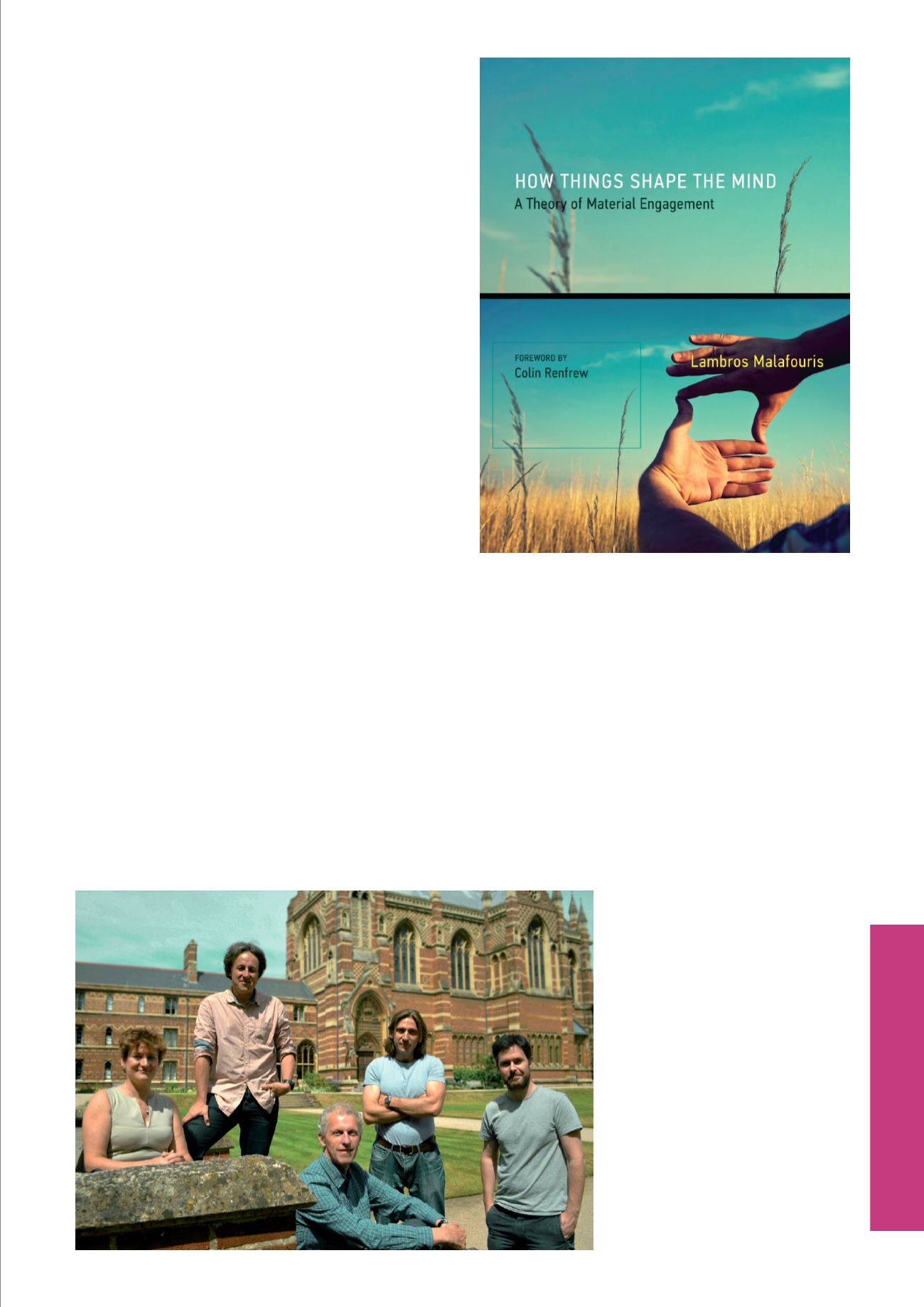
The Keble Advanced Studies Centre
13
and extra-neural resources. Simply put, we aim to understand how
the human brain, working in concert with the human body, interacts
with material culture in performing a creative task.
Can you briefly explain the main argument of your book,
How
Things Shape the Mind
? (right)
I will try using my favourite philosophical example: think of a blind
person with a stick. Where does the blind man’s self end and the
world begin? The unity of the blind person and the stick nicely
reminds us of something that many people forget, namely, that
it is in the nature of human intelligence to remain amenable to
drastic deep reorganization by incorporating new technologies and
innovations. We are used to thinking of our sapient minds, with all
our unique creative abilities, as the apex of human evolution. The
approach I take in my book, instead, sees the human mind as an
incomplete and unfinished project, in some sense ‘blind’, and thus,
potentially, in a state of on-going creative evolution. My argument
is that we have a plastic mind which constantly improvises and
incorporates new tools which make us what we are. It is especially
in the latter sense that the example of the blind man’s stick
encapsulates the spirit of Material Engagement Theory (MET).
Are there any specific issues in creativity that you believe may
provide especially fertile ground for exploring these ideas?
For the present, we focus on five strongly interrelated themes,
namely, embodiment, plasticity, ecology, evolution, and materiality.
We want to understand the evolutionary links between active mind,
creativity and innovation and to highlight the role and redefine the
meaning of material culture in that process.
Why is that important or useful?
For many reasons. Let me give you one example. As I said, we
humans, more than any other animal, are subject to enduring creative
evolution which is mental as much as it is physical. What is the
meaning of that? Two things: First, that biology is only part of the
story of what makes us human. Second, that creativity is a product
of interactive networks (neural, social, or cultural) rather than of
the isolated individual genius. There are some further important
implications. For one thing, creativity can no longer be seen as a gift
you inherit from your parents. Instead, it is an accomplishment of the
interaction between the individual and the environment. For another,
it might well be that the best way to construct creative individuals
is by constructing creative environments and social institutions.
The question of course, is how do we do that? I think that trying to
make better sense, and take full advantage, of the seemingly unique
human predisposition to reconfigure our bodies and extend our minds
by using material innovations offers a good starting point. Here is
where our work in the Cluster comes in.
Would you consider this to be an area in which your research
might prove relevant for policy and the general public?
These are all issues with immediate real-world relevance. We should
not forget that whether in business, technology, science, or art,
creativity has come to be seen as a major driver of prosperity and
social well-being. Creativity, being an essential feature of what it
means to be human, is and must remain a property of everyone,
independent of age, culture or educational background. Although the
work we do at the ASC Creativity Cluster is still at a formative stage
and its impact cannot be quantified yet, one can already see how
it could potentially contribute to this direction. That is of course, if
creativity is what we really want and choose to promote as a society.
Do you think that institutions like the Keble ASC promoting
interdisciplinary research can contribute to that end?
There is no doubt about it. Cutting across traditional disciplinary
boundaries and challenging familiar ways of thinking is key.
Interdisciplinarity itself can be seen as a form of creativity. The
difficult question is rather how we do this
seriously and effectively. Keep in mind
that although, in recent decades, there has
been much discussion over the value of
‘interdisciplinarity’, the fact of the matter
is that true cross-disciplinary research has
been offered very limited space to grow. I
am not talking here about the usual ‘two-
day interdsciplinary workshop’ format,
but instead, of a long-term sustained
commitment. This demands an altogether
different kind of vision. It necessitates the
will to adopt a radically different approach
to cross-disciplinary research and
dialogue. This is also why institutions like
the Keble ASC are indeed so important,
not only for academic research but for
society as a whole. They facilitate, support
and promote this kind of truly radical
thinking.
Creativity Cluster Members (left to right):
Professor Sarah Whatmore, Professor Tom Higham,
Professor Chris Gosden, Dr Lambros Malafouris, Dr
Simon Butt (not pictured: Professor Steve Rayner).


